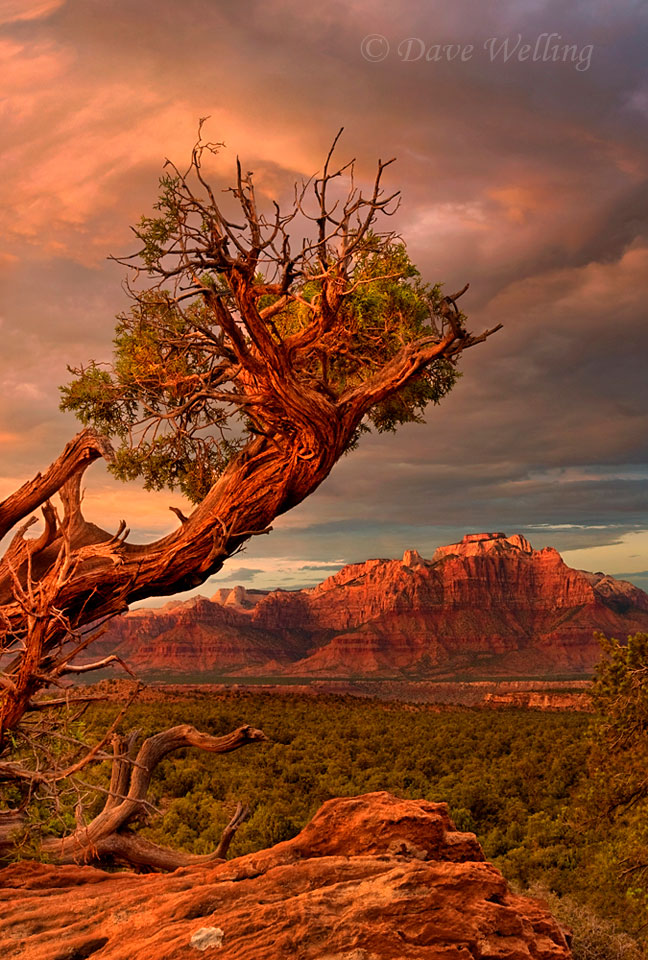You've discovered a great landscape, the light is perfect and you know which elements to include in your composition. To select the right lens to create the perfect image you need to understand how different focal lengths affect viewing perspective. How will different focal length lenses affect the angle of view and the depth of field? Or the compression of the elements in the scene? Most people know the angle of view for a lens will widen, and the depth of field (or portion of the image in apparent focus) will increase as you shorten focal length. However, not everyone knows lenses will "compress" the elements of a scene, or make them appear closer as you increase focal length. Consider the following two images.
For this image below of the Minarets and Lemmon's paintbrush in California's Eastern Sierras, I wanted to create a grand scenic where you see all the way from "here to there". The use of a wide angle lens, about 16-17mm, creates an almost infinite apparent depth of field. All key elements, from the flowers, through the layered granite rocks, to the sunlit Minarets, appear in focus. The wide angle lens also expands the elements of the scene creating a grand vista where they all complement each other with no single element standing out.

With a wide angle lens you can get very close to the front element of the image (the flowers) while also keeping the distant mountains in focus. If the flowers were not in focus, the viewer's eye would stop at the blurred front element. Instead, the sharply focused pink flowers become an important element, drawing the viewer into the scene. Positioning the flowers as a key element at the base of the composition draws the viewer into the scene, while not overpowering the image. Because the elements complement each other, there is an uninterrupted flow in viewing the scene from the bright pink flower to the distant sunlit Sierras.
Conversely, look at the image of the twisted juniper framing the famous mountain formations of Zion National Park (seen from a totally different location outside the Park). Here, there are two key elements: the juniper and the distant mountains. The expanded perspective of a wide angle lens would significantly diminish the mountains, reducing their compositional importance and affect the balance of the two elements. By selecting a 70mm medium telephoto lens and backing up several feet from the juniper, I could keep the elements in focus and compress the key elements bringing the mountains into a prominent position.
Note: In both cases an aperture of approximately f-16 was necessary to keep all elements in apparent focus. Using the depth-of-field preview insured this would be the case.
About the author: Dave Welling is a full time professional photographer specializing in wildlife, landscape and nature with over 75,000 6x7, 6x4.5, and 35mm film and digital images. He has been capturing evocative images of the natural world for over 25 years, producing the highest quality images for publication. His images often capture unique behavioral characteristics of wildlife or special lighting or weather conditions of landscapes. You can see more of his work at www.strikingnatureimagesbydavewelling.com.
Have something to add to the story? Leave a comment or email editor@outdoorphotographyguide.com


I would love to be able to take amazing photos like the ones displayed in this article. But due to a drastic life change I have to take photos with the lenses I have already. I have a Nikkor 50mm prime lens and my kit lens a Nikkor 55-200mm lens and my camera of choice the Nikon D5200. Am I still able to take photos like the ones shown or do I need to have more lenses to achieve these amazing photos.
Beautiful photographs, and a very helpful article! As a novice photographer I found this comparison really helpful, I'd love to read more articles like this comparing effects of different lenses; it makes so much more sense when someone says 'look, if you want to take a photo a bit like this, this lense does that, or if you prefer THIS then that lense does this!' Bravo. :-)
Ian a premium member how can I get the full photo courses not just the preview? Could you send me a phone number so I could talk to a person from "outdoor photography guide "